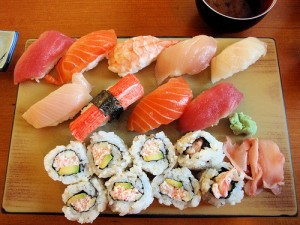Japanese Food
 A key part of learning about any new culture is getting to know their food. In fact a meal for many people is their first introduction to a country and a people. I will never forget my first bite of Thai food- life changing, not an exaggeration, although at the time I took it I could not have told you anything about Thailand. The restaurants common in any city are often signposts to the history of immigration to the region and to the current diversity of the population. In Milwaukee, a medium sized city in the Midwestern US, we have Irish bars, Jewish delis, historic German, Polish, Italian, Chinese and Soul food restaurants, and somewhat newer Indian and Thai establishments. The newest arrivals to the city dining scene have been Korean and Japanese restaurants. Japanese cuisine, while always popular on the West Coast, has been growing in popularity in other parts of the country and in fact the world. Considering that Japan counts with some of the oldest people in the world- there is great incentive to learn to appreciate this healthful, flavorful cuisine.
A key part of learning about any new culture is getting to know their food. In fact a meal for many people is their first introduction to a country and a people. I will never forget my first bite of Thai food- life changing, not an exaggeration, although at the time I took it I could not have told you anything about Thailand. The restaurants common in any city are often signposts to the history of immigration to the region and to the current diversity of the population. In Milwaukee, a medium sized city in the Midwestern US, we have Irish bars, Jewish delis, historic German, Polish, Italian, Chinese and Soul food restaurants, and somewhat newer Indian and Thai establishments. The newest arrivals to the city dining scene have been Korean and Japanese restaurants. Japanese cuisine, while always popular on the West Coast, has been growing in popularity in other parts of the country and in fact the world. Considering that Japan counts with some of the oldest people in the world- there is great incentive to learn to appreciate this healthful, flavorful cuisine.
Naturally, the traditional dishes of Japan developed based on its own unique history as well as the geographic and climatic situations of the country. Rice has been the most important staple crop for over 2,000 years. In fact the importance of rice cannot be overstated. It is not only the base of most meals but for several products including: cakes, crackers and miso. Vegetables, seafood and tea round out the daily diet. The most commonly recognized Japanese dishes include sushi, tempura, tofu and flavorful noodles. Interestingly, tea was introduced to Japan from China along with chopsticks and soy sauce; the deep-frying of foods such as tofu and tempura was introduced by the Dutch and the Portuguese in the 16th Century.
The most practiced religion on the island, Buddhism, has influenced cooking and dining styles. Buddhism places great influence on the seasons and the harmony within a meal. Seasonality of foods is key in Japanese dining. Buddhism also introduced the idea that meals should feature five flavors and colors: sweet, spicy, salty, bitter and sour; and yellow, black, white, green, and red. Emphasis is also placed on the presentation and appearance of dishes. The better a dish appears, and the more suited it is to the environment the better it is said to taste.
A few notes on politeness. A hot towel is often provided before a meal but is used to clean hands only. The bowl is held in the left-hand and the chopsticks in the right to avoid collisions at the table. It is impolite to pour soy sauce directly on to rice or soup. Instead a bowl is provided on the table and foods should be dipped into it. Picky eating and special requests at restaurants are generally frowned upon the more socially acceptable thing is to eat what is provided. As a traveler, just be sure to ask nicely if you have special needs.